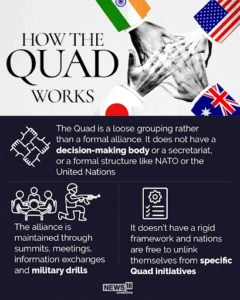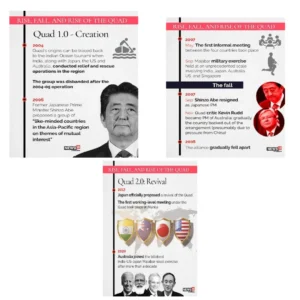Introduction
- PM Shri Narendra Modi attended the 4th QUAD Summit in Delaware, USA on 21st September 2024.
- President of the USA Joe Biden hosted PM Narendra Modi, the PM of Australia Anthony Albanese, and the PM of Japan Fumio Kishida at the QUAD Leaders’ Summit.
- The United States will host the 2025 Quad Foreign Ministers Meeting, and India will host the 2025 Quad Leaders Summit.
Understanding the Quad Grouping
- The Quadrilateral Security Dialogue (Quad) is an informal strategic forum comprising the USA, India, Japan, and Australia, aimed at promoting a free, open, and prosperous Indo-Pacific region.

History of Quad
Quad 1.0 (Origin)
-
-
- 2004: The Quad’s origins trace back to 2004 when these countries collaborated to coordinate relief efforts following the devastating tsunami in the Indian Ocean.
- 2007: The concept was officially proposed by Japanese Prime Minister Shinzo Abe. However, it lost momentum as Australia withdrew under pressure from China amid rising tensions in the Asia-Pacific.
-
Read also: Bombay High Court Strikes Down Centre’s Amended IT Rules | UPSC
Quad 2.0 (Revival)
-
-
- 2012: The idea re-emerged, with Japan’s Prime Minister promoting a ‘Democratic Security Diamond’ involving the four nations: US, Japan, India, and Australia.
- 2017: The Quad was revitalized in response to China’s assertiveness in the South China Sea, marking a significant shift in geopolitical dynamics.
- 2021: The first formal summit took place, with an official declaration emphasizing commitment to a region characterized by democracy, inclusivity, and resilience against coercion.
-
|
|
Recent Outcomes of the Quad Summit (2024)
Maritime Security:
-
-
- MAITRI Maritime Initiative: A new regional initiative focusing on training partners to enhance maritime law enforcement and deter illegal activities, with India hosting the inaugural symposium in 2025.
- Indo-Pacific Partnership for Maritime Domain Awareness (IPMDA): Expanded cooperation to boost regional capabilities against illicit maritime activities.
- Quad Coast Guard Cooperation: Aims to improve interoperability among the coast guard forces of member nations, including a scheduled Quad-at-Sea Ship Observer Mission in 2025.
-
Humanitarian Assistance and Disaster Relief:
-
-
- Indo-Pacific Logistics Network Pilot: Development of a joint airlift capability to improve humanitarian response in the region.
- Aid for Cyclone Yagi: Announcement of $4 million in humanitarian assistance for Vietnam post-Typhoon Yagi.
-
Health Initiatives:
-
-
- Quad Cancer Moonshot Initiative: Focused on combating cervical cancer through enhanced HPV vaccinations and access to screenings in the Indo-Pacific.
-
Education and Research:
-
-
- Quad Scholarships: India introduced fifty scholarships worth $500,000 for students from the Indo-Pacific.
- Quad BioExplore Initiative: Joint research initiative utilizing AI for agricultural advancements among member countries.
-
Infrastructure and Connectivity:
-
-
- Centre for Cable Connectivity and Resilience: Development of undersea cable networks to support global data traffic.
- Quality Infrastructure Development: Commitment to sustainable infrastructure projects, enhancing connectivity in South Pacific nations.
-
Climate Change and Clean Energy:
-
-
- Q-CHAMP: An initiative aimed at enhancing resilience against climate impacts throughout the region.
-
Significance of the Quad Grouping
Strategic Counterbalance to China:
-
-
- The Quad acts as a counterweight to China’s growing influence, advocating for a ‘free and open Indo-Pacific’ crucial for regional stability.
- Example: The Quad emphasizes support for ASEAN centrality and peaceful dispute resolution in the South China Sea.
-
Enhanced Maritime Security:
-
-
- The grouping focuses on joint exercises and coordinated maritime responses.
- Example: The IPMDA and annual Malabar exercises reinforce the rule-based order in the region.
-
Economic Cooperation:
-
-
- Collaboration on infrastructure and resilience is vital for the Indo-Pacific.
- Example: The Quad Infrastructure Coordination Group identifies projects as alternatives to China’s Belt and Road Initiative.
-
Technology and Supply Chain Resilience:
-
-
- Aiming for robust supply chains for critical technologies.
- Example: Initiatives like the semiconductor supply chain initiative enhance material security.
-
Public Goods Provision:
-
-
- The Quad addresses broader issues like health security.
- Example: Initiatives such as the Quad Vaccine Partnership ensure equitable access to vaccines.
-
Humanitarian Assistance and Disaster Relief:
-
-
- The Quad’s operations are focused on disaster relief across the Indo-Pacific.
- Example: The Indo-Pacific Logistics Network Pilot facilitates humanitarian responses during crises.
-
Significance of the Quad Grouping for India
Strengthening Global Standing:
-
-
- India’s active participation in the Quad has positioned it as a leading voice in the Indo-Pacific, enhancing its influence in international forums such as the G20 and the United Nations.
- Example: India’s hosting of the Quad summit in 2021 marked its growing leadership role in shaping regional security architecture.
-
Support for India’s Vision:
-
-
- The Quad complements India’s ‘Act East’ policy by fostering deeper engagement with Southeast Asian nations, aligning with India’s strategic interests in the region.
- Examples: India’s collaboration with ASEAN countries on trade, infrastructure, and security initiatives reflects the synergy between the Quad and India’s regional goals.
- India and Singapore engage in trade agreements and joint exercises, enhancing economic ties and defense collaboration.
- India has worked with Thailand on infrastructure projects, particularly in the area of connectivity, such as road and port development.
-
Counterbalance to China:
-
-
- Quad initiatives provide India with alternatives to counter Chinese investments, particularly through collaborative infrastructure development.
- Example: The Quad Infrastructure Coordination Group aims to fund and implement projects in the Indo-Pacific, serving as a counter to China’s Belt and Road Initiative.
-
Access to Advanced Technologies:
-
-
- The Quad’s emphasis on resilient supply chains supports the growth of India’s technology sector, reducing reliance on imports for critical components.
- Example: Initiatives like the semiconductor supply chain collaboration are intended to boost India’s capabilities in high-tech manufacturing, enhancing its self-sufficiency.
- India aims to enhance its semiconductor manufacturing capacity and has been engaging with both the U.S. and Japan to attract investment and technology transfer.
-
Health and Vaccine Collaboration:
-
-
- The Quad Vaccine Partnership strengthens India’s role as the ‘pharmacy of the world’ by promoting vaccine production and distribution across the Indo-Pacific.
- Example: India’s production capabilities were utilized to support the COVAX initiative, providing vaccines to various countries in the Indo-Pacific, including Nepal and Sri Lanka, thus extending India’s influence and commitment to global health.
-
Challenges Faced by the Quad Grouping
Perception as Anti-China:
-
-
- The Quad is often viewed as an anti-China alliance, facing criticism from China as a ‘mini-NATO.’
-
Divergent Strategic Interests:
-
-
- Member nations have varied priorities, impacting commitment levels to collective security.
- Example: During the 2020 Galwan Valley clash between Indian and Chinese troops, while the U.S., Japan, and Australia expressed support for India, their direct involvement was limited. India opted not to seek military assistance from its Quad partners, reflecting its longstanding policy of strategic autonomy.
-
Lack of Institutionalization:
-
-
- As an informal grouping, the Quad lacks a formal framework for long-term strategic initiatives. For instance, while the Quad countries discuss various initiatives, including maritime security and infrastructure development, there is no established process for tracking progress or ensuring accountability among member states.
-
Economic Dependencies on China:
-
-
- Significant economic ties with China can constrain member states’ willingness to adopt anti-China measures.
- Example: Between 2007 and 2021, China’s state-owned enterprises and private companies poured a total of $158 billion into Australia, including by investing or acquiring mining and energy companies, infrastructure, wind turbine farms and a dairy processor.
-
Lack of Consensus on Security Issues:
-
-
- India’s preference for strategic autonomy limits deeper military cooperation within the Quad.
- During the discussions surrounding the AUKUS pact (Australia, UK, and US), India expressed concerns about the implications for regional security dynamics. While the other Quad members generally supported AUKUS as a means to counter China’s influence, India opted to remain neutral and did not participate in discussions aimed at expanding military ties.
-
Challenges in Membership Expansion:
-
-
- Including additional countries could dilute the Quad’s cohesion and focus.
- For instance, while South Korea has expressed interest in joining the Quad discussions, its priorities often align more closely with economic cooperation rather than the security focus that characterizes the Quad’s current agenda.
-
ASEAN Concerns:
-
-
- Some ASEAN nations worry that the Quad could undermine regional dialogue and cooperation.
- Example: Malaysia has shown hesitance, with leaders expressing concerns that the Quad’s activities might create divisions within ASEAN and detract from its efforts to maintain unity and centrality in regional affairs.
-
Read also: Indus Water Treaty: Key Agreement Between India & Pakistan | UPSC
Way Forward
- Strengthening Institutionalization: Establishing a formal secretariat and regularized meetings could enhance coordination and execution of strategic projects.
- Enhancing Military Cooperation: Expanding joint naval exercises like Malabar could improve operational readiness against threats.
- Engaging with ASEAN: Initiating a dialogue with ASEAN can align efforts on mutual issues like maritime security and economic resilience.
- Establishing an Economic Framework: A comprehensive Quad economic framework should include initiatives for digital trade and collaboration on emerging technologies.
- Expanding Membership: A ‘Quad Plus’ dialogue could involve nations like South Korea and Vietnam to enhance collaborative efforts.


